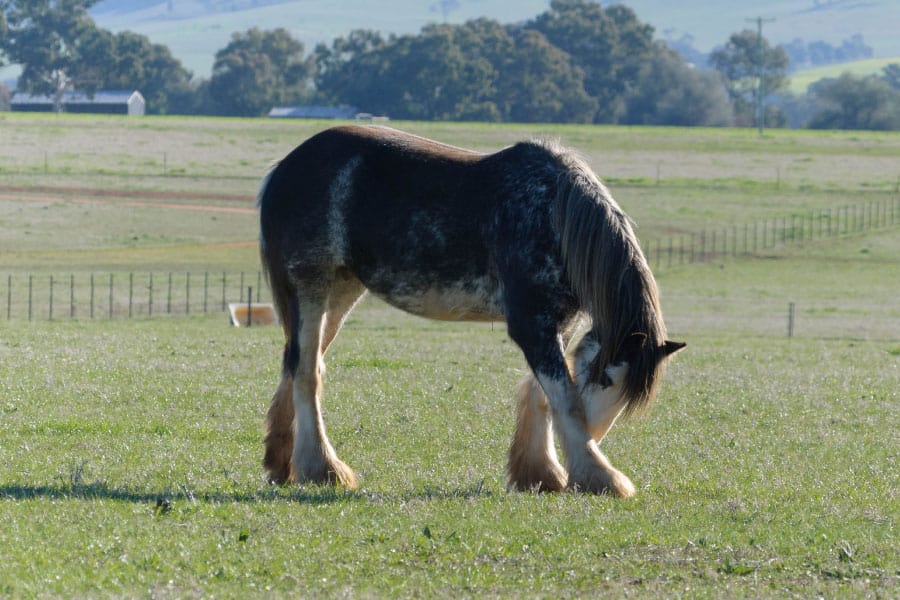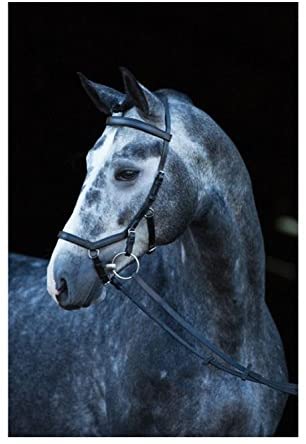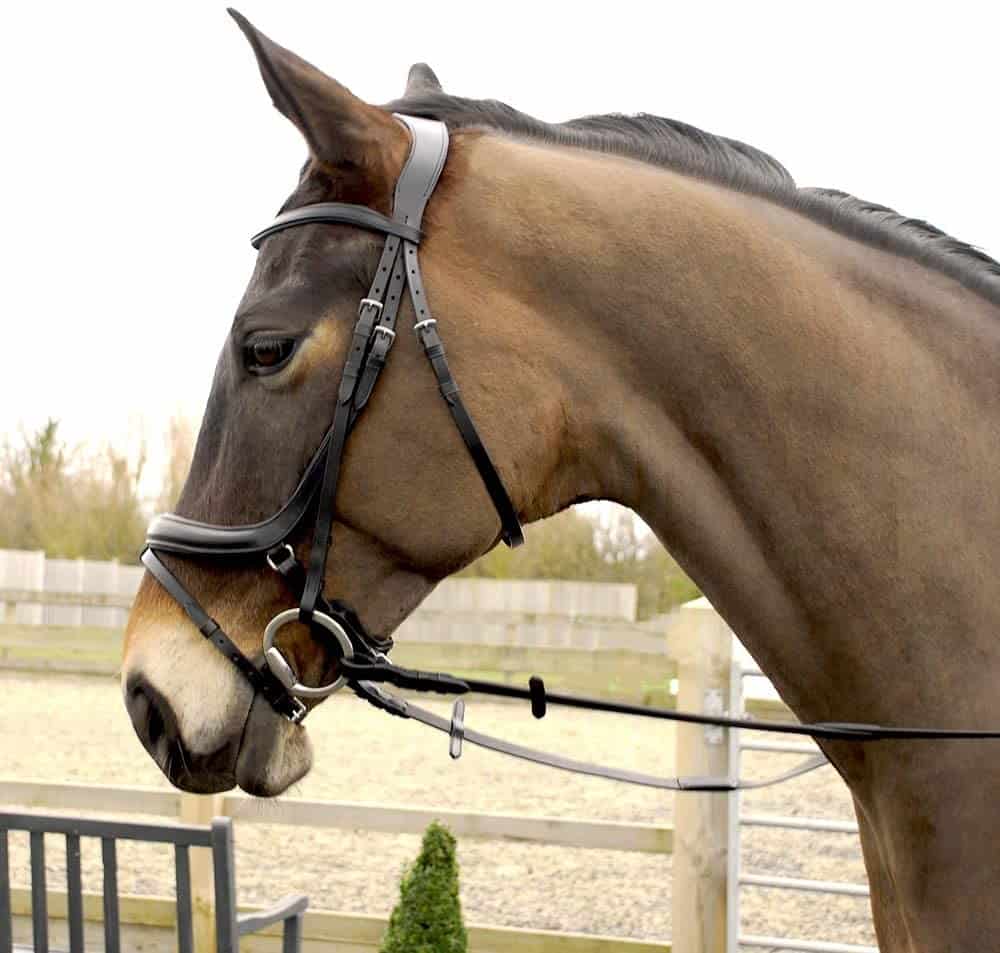- Your source for stall mats, rubber arena footing, arena harrows and arena dust control.

Have you ever stood next to your horse, and they start rubbing their head against your hand or even up and down your body? Your horse can also rub their heads on poles, their legs, or the side of the stable. There can be many reasons as to why they do it. Most of the time, your horse is trying to tell you something.
Why does a horse rub its head on you? The most common reasons why a horse would rub their head on you is because their muzzles go numb or itch due to the bridle that puts pressure on their facial nerves or out of irritation, which most commonly occurs right after or during riding. However, it could also be because of disease or behavior problems.
Knowing the anatomy of your horse’s head and how the bridle interacts with your horse will give you an indication of why their muzzles go numb or itchy. Your horse might also have a skin condition, a hypersensitivity to biting insects, or other diseases. We will also look at our top 3 anatomical bridles that may make it more comfortable for your horse.
Anatomy of the horse’s head
Knowing the basic anatomy of your horse’s head is very important. A properly fitting bridle is just as important as a properly fitted saddle. Your horse’s head has many capillaries, veins, and nerves right under the skin. The skin on the head is also thinner than the rest of the body.
The bridle sits on top of these nerves, fascia, and blood vessels. A too-tight bridle will pressure the tissues and cause serious damage or behavioral issues. There are three main structures that any horse owner and rider needs to be aware of.
Main facial nerves
All throughout the body are nerves running from the spinal cord to everywhere in the horse’s body. The main facial nerve is part of a group of nerves that are referred to as Cranial nerves. Cranial nerves brand out from the brain itself and not the spinal cord.
One of the most important facial nerves (cranial nerves) is the Trigeminal nerve. It is a complex nerve that has three branches. This nerve is responsible for: Temperature, pressure, proprioception, pain, chewing, and controlling muscles in the jaw.
Pain caused in this nerve can cause behavioral issues like difficulty bridling or putting the halter on, head shaking or tossing, chewing on the bit, sensitivity to the poll area, tensed muscles in the jaw, and head rubbing.
An ill-fitting bridle can increase pressure in any of the 12 cranial nerves.
Roles of the different nerves include the following:
- Balance
- Heart rate
- Hearing
- Smell
- Vision
- Eye movement
- Muscles that move the head
- Sensation in the face
- Motors muscles in the face
- Facial expressions
- Taste
- Swallowing
- Salivary gland regulation
- Tongue movement
- Vocalization
Bony nasal and underlying structures
The nasal bone of the horse ends in a soft piece of cartilage. The nasal bone has many “holes” for insertion and exiting of facial nerves and blood vessels. There is mostly fascia and skin covering the top of the nose and minimal muscle. The skin over the nose is also very thin and sensitive.
The pressure from the noseband directly affects the movement, elasticity, and purpose of the fascia and nerves. A dropped noseband or a flash is the most damaging as it can apply pressure directly onto the nerves and is the most restrictive on the fascia.
The more modern high and wide cavesson noseband can create movement dysfunction on the fascia and nerves and causes discomfort. The regular positioning of a normal cavesson noseband (in the middle, two fingers below the facial crest, with two fingers width space between the nasal bone and the noseband) has been found to cause the least amount of discomfort and effect on the fascia and nerves.
Arteries, veins and capillaries
There are many arteries, veins, and capillaries that are found in the head of the horse. At the very least, the rider should know how to properly fit any bridle to ensure that there is minimal pressure applied to the head of the horse to ensure that blood flow to and from the horse’s head and face is not hindered.
The blood vessels in the head are used for oxygen distribution to muscles, nerves, and other organs, removing deoxygenated blood, temperature regulation, and maintaining the health of all the tissues in the head. Damage to the blood vessels in the head can cause pain and discomfort for the horse and result in behavioral issues.

Reasons why a horse will rub its head on you
Now let’s look at the possible reasons why your horse will rub its head on you.
Fungal dermatitis
Also called Ringworm, due to its round hairless patches with crusty skin is caused by a fungus. It is found most commonly on the face, neck, and shoulders. It may be sore or itchy but otherwise causes no discomfort. According to the name, it sounds like a worm causes it, but it is a fungal infection, commonly caused by the Microsporum or trichophyton families.
The fungus consumes keratin, the protein that forms part of the hair and the epidermis. The fungus can survive up to several months in the surfaces of the horse’s environment, grooming kits, and tack. It is highly contagious and spreads through contact with other horses and infested equipment.
Mange
Although not common, there are cases where mange can appear on the horse’s head and under their jaw. It starts with small round bumps that are soon followed by hairless spots with thickened skin. It is a parasitic infection caused by microscopic mites that are not visible to the naked eye.
In the USA the most common mange is caused by chorioptes equi. There are other types of mange: sarcoptic (equine scabies), psoroptic (mane mange), demodectic, harvest mange, and straw itch mites. They mainly affect the legs of heavily feathered draft horses, while demodectic equi most commonly affects the face, neck, and shoulders.
This is a very itchy and irritating condition but also rare in horses. The intense itching is caused by hypersensitivity to the mite’s saliva and feces. Sarcoptic mange is one that mainly affects the head, neck, flanks, and abdomen.
Hypersensitivity to insects
Most horses are used to the regular flies, mosquitoes, and midges present at any stable yard, but some horses are more sensitive or even allergic to the bites of these insects.
Sweet itch, also known as summer itch, is an example of horses that are allergic or hypersensitive to culicids midges or even biting flies. The symptoms are small bumps that are extremely itchy, and it results in small patches of hair loss and flaky skin. These symptoms are most commonly seen along the neck, face, and shoulders.
Horses will be very irritated when there are midges and flies around. Horses also scratch themselves constantly against their legs, using their teeth, or against other objects.
It is often frustrating for the owner and the horse as it will occur every summer and spring season and tone down in the winter. It is not an infectious disease as it has to do with the immune system of the specific horse.
Damage to the facial nerve
A damaged facial nerve can cause a constant stimulation of an itchy sensation on the horse’s face. The damage can be caused by incorrectly fitting bridle over a long period of time, trauma to the nerve, a viral infection, congenital abnormalities, and toxic substances.
Symptoms can include scratching against all available surfaces, hair loss due to constant rubbing, open wounds, and overall irritation.
Decreased blood flow in the head.
Decreased blood flow to the head and face can be caused by restriction from the halter or bridle (for example, the noseband being too tight) or damaged arteries. A too-tight noseband or flash can cut circulation to the muzzle and result in pins and needles feeling in the Muzzle.
This will result in the horse rubbing their muzzles, and usually occurs after riding and when you take the bridle off.
Horses with many intravenous injections can damage the jugular vein, resulting in scar tissue formation. It can apply pressure to the aorta, which is the main artery for blood supply and decreased blood flow.
Social interaction
Horses are highly social creatures, and they communicate through body language and physical touch. A horse will rub their heads on you as a bonding moment or establish dominance and personal space.
When your horse uses its head to push you, this is usually to establish dominance. Some horses groom each other to bond, strengthen their relationship, and reach each other’s itchy spots that they can’t reach themselves.
It is not recommended to let your horse rub their heads on you, push you with their heads or pull you around on the lead as it asserts dominance, and you do not want to be associated with another friend or another horse.

How to treat the conditions causing your horse to tub its head on you
Ringworm treatment
Isolate the horse. This condition is contagious and can spread from horse to horse or another animal. It can even affect the handler or rider. The horse should be kept separate with their own separate tack, equipment, and grooming kit. Having separate equipment for each horse is also part of good horse management practice.
Clip the hair around the lesions and remove crusty skin or scabs. This will allow the medicine more contact with the fungus and increased sunlight and oxygen on the affected areas. Clean the lesions and surrounding skin with antiseptic and anti-fungal soap – chlorhexidine.
Some anti-dandruff shampoo or over the counter anti-fungal creams are effective against ringworm. Exposure to oxygen and sunlight will also kill the fungi, thus increasing turn out time will be a good option and treatment.
It is very important to consult with a veterinarian before administering any kind of treatment. Not all creams, soaps, or other medicine will be effective and might be dangerous to your horse. The vet can also correctly diagnose ringworm as other skin conditions look similar.
Mange treatment
The main treatment for mange is anti-parasitic ointments, sprays, washes, and internal medicine. Cortisone cream should be avoided as, in some cases, it can worsen the condition due to the cortisone affecting the mites. A skin scrape will be done to examine under a microscope for mites.
Sometimes the mites will not be visible in skin scrapings, and then a skin biopsy will be done. Mange is highly contagious, and treatment should be done quickly, thoroughly, and applied to all other animals that got into contact with the affected horse.
The vet will prescribe a lime-sulfur solution that can be sprayed, sponged, or used as a dip. Several treatments will be needed about two weeks apart. Another treatment is drugs referred to as macrocyclic lactose, and this is also effective.
As for the other variations of mite infestations, different types of medications and treatments will be needed. It is recommended that one calls the vet immediately in a suspected mange case.
Hypersensitivity to insects treatment
Treatment for these types of allergies can be frustrating as not all treatments work for all horses. It is important to minimize the contact between the insects and the horse. A flysheet for during the day paired with Fly spray that contains DEET is of utmost importance.
for during the day paired with Fly spray that contains DEET is of utmost importance.
DEET is the only ingredient that can work against midges and mosquitoes. Citronella in fly spray should be avoided as it can attract midges. Spraying stable, safe poison in and around the stables can also help veer off midges and flies.
is the only ingredient that can work against midges and mosquitoes. Citronella in fly spray should be avoided as it can attract midges. Spraying stable, safe poison in and around the stables can also help veer off midges and flies.
A soothing ointment can be rubbed on the affected areas to minimize the irritation of the skin. Garlic and Turmeric have been shown to help with inflammation and itchy skin, but a vet must be consulted about the dosage given to the horse as it can cause Anaemia.
Cortisone and corticosteroid cream can be used as a treatment in more severe cases, but it is not safe for long-term use as it can cause damage to the kidneys, liver, and spleen.
Damage to the facial nerve treatment
Damage to nerves is untreatable. Depending on the severity, the body may be able to repair or regenerate the nerve, but it takes a very long time. In the case of severe damage, the nerve may not ever regain function. In the more severe cases, the itchy sensation may go away, and the affected areas will be numb.
Decreased blood flow to the head treatment
Ensure that your bridle is fitting properly and that you can fit two-finger between the noseband and the nasal bone after it has been fastened. In the case of damaged blood vessels, the surrounding blood vessels will continue to function and take over the role of the damaged vessels.
If the damage is very severe, it can damage the muscles or internal organs of the head, and a surgical bypass can be done to restore the blood flow.
Social interactions treatment
It is up to the owner and the horse’s trainer to know the difference between bonding and domination behavior in the horse. Proper groundwork and stable manners are a very important foundation in every horse’s training.
Once the horse has the basics of groundwork established, the dominant role in the rider-horse relationship should be clear and should be maintained by the rider.
Groundwork includes:
- Walking and trotting in hand with the horse staying at your shoulder and not overtaking you or staying behind
- Lungeing on a lunge line without dragging the rider or pulling tight on the line, listening to body language and voice cues
- Join up exercises
- Standing still when asked to stand and not pulling towards the grass
- Boxing properly
- Respecting the riders space – staying within the riders boundaries, backing up when asked, and not standing “on top” of the rider
- Standing and relaxing while being groomed
- Allowing the rider to catch the horse when in the paddock
- Standing while mounting
Our top anatomical bridles
Here are our recommendations for anatomical bridles.
Rambo Micklem Multibridle
The Rambo micklem was one of the first anatomical bridles and was designed to sit comfortably around the horse’s head. The micklem overall avoids pressure on sensitive areas. William Micklem is the designer of this bridle and designed it to be the best fitting, most effective, most flexible, and most comfortable bridle. The nosepiece is wide to distribute pressure; the bridle’s shape is designed to alleviate pressure on sensitive areas and avoid the facial nerve. The pole piece is wide and cut back around the ears to ensure comfort in the poll area.
Buy on Amazon.com
Collegiate Comfitec Crystal Bridle
This anatomical bridle is made with high quality and soft leather. The bridle evenly distributes pressure along with the poll with added padding for comfort around the ears. The ergonomic noseband minimizes pressure on the upper jaw and molar teeth. The check strap and padded rings alleviate the pressure on the facial nerve.
Buy on Amazon.com
Rhinegold Leather Pro-anatomical
This soft leather bridle has a curved and padded poll to minimize pressure on the poll and around the ears. The bridle is anatomically shaped to lessen the pressure on the pressure points around the facial crest, checks, and ears.
Buy on Amazon.com
Conclusion
If you notice that your horse is suddenly rubbing its head on you or its legs, poles, or other surfaces, you can assume that it is either the bridle, halter, fly mask, or a skin condition.
Check the pattern of when it happens. If it is just after riding, it is safe to assume that it might be the bridle. If the bridle is fitted correctly, it might be the design of the bridle. Trying different styles of bridles will help you find the most comfortable one for your horse.
If you suspect a skin condition causing the itchiness, it is best to consult with a veterinarian before seeking treatment.
If it is a behavioral problem, then the rider and trainer need to re-establish proper groundwork and manners.




